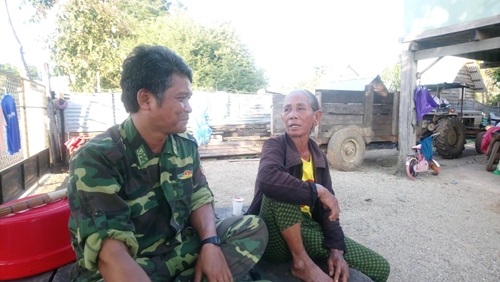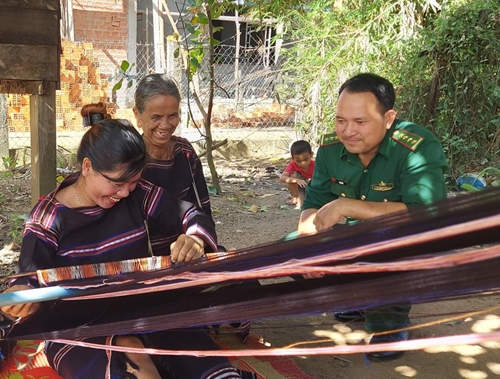The call of good border land
The total natural area of Gia Lai provincial border areas is more than 140,000 hectares while the population is only about 50,000 people and nearly 60% of them are ethnic minority people. These people live in 48 villages in seven communes of three districts. It can be said that the population density in these border areas is sparse. As a result, it is difficulty to attract investment in developing social security. However, these areas are still called a good land thanks to the presence of border guards who have promoted their strength to develop it.
    |
 |
|
Border guard Ro O Thuy (left) creates imprints in wet rice development model in Ia Mo commune. |
Colonel Ro Mah Tuan, Party Secretary and Political Commissar of Gia Lai provincial Border Guard Command and former deputy of the 14th National Assembly, is a bright example. After graduating from the Border Guard Academy more than 20 years ago, Tuan was assigned as the head of a mass mobilization team of Ia Mo Border Post under the Gia Lai provincial Border Guard Command. At that time, the security situation in the Central Highlands was very complicated. Hostile and reactionary forces promoted dissemination activities, incited gullible people, sabotaged the national unity bloc, organized and conducted illegal border crossings. Learning that, Tuan and his teammates sped up dissemination work, encouraged local people to join hands in the program in which all people safeguard the border, and prevent illegal border crossings. Thanks to their efforts, local people many times promptly arrested strangers infiltrating the locality to commit illegal acts.
There was a case of a local “using the tactics of the enemy to fight the enemy” and handing over a group of people illegally crossing the border to the border post. Apart from that, many cases related to spreading superstition and maintaining backward practices in the community were discovered and prevented by local people themselves thanks to the indispensable role of the border guards. Despite difficulties, that border area is a good land for border guards to further devote.
Laying deep impressions on local people with his creative and effective deeds and acts in mass mobilization work, border guard Tuan also obtained another “achievement”: He got married with a local girl named Ro Com Toa in Klah village, Ia Mo village.
"Ch'rao birds" flying back to the nest
In the Gia Lai provincial Border Guard Command, more than 100 officers and soldiers are from ethnic minority groups and holding different positions. The rate of ethnic minority troops in the command is higher than the target of 6.2% set in the resolution of the 13rd congress of the provincial Border Guard Party Organization for the 2020 - 2025 period.
    |
 |
|
The village is full of laughs with the presence of border guards. |
In any positions, these ethnic minority troops have well performed their duties, stood side by side with local people.
In Ia Mo commune, Ia Mo Border Post launched a wet rice development model. The post established a “three-member team,” including head of the mass mobilization team Ro O Thuy (present Major, Deputy Political Commissar of Ia Puch Border Post, Gia Lai provincial Border Guard Command), non-commissioned Major Le O Y Win and non-commissioned First Lieutenant Ksor Lem. The team acted as real farmers to instruct locals on how to plough a field, plant, take care of and harvest rice. Their “hands-on” activities helped local people easy understand and follow.
These border guards have not only talked a lot, comprehended a lot, but also done a lot. They have mastered each stage of cultivation, each skill of using motorized vehicles to make wet rice plants really take root in the village.
These ethnic minority border guards are like "Ch'rao birds" flying to their nest to develop the border areas.
Source: bienphong
Translated by Mai Huong